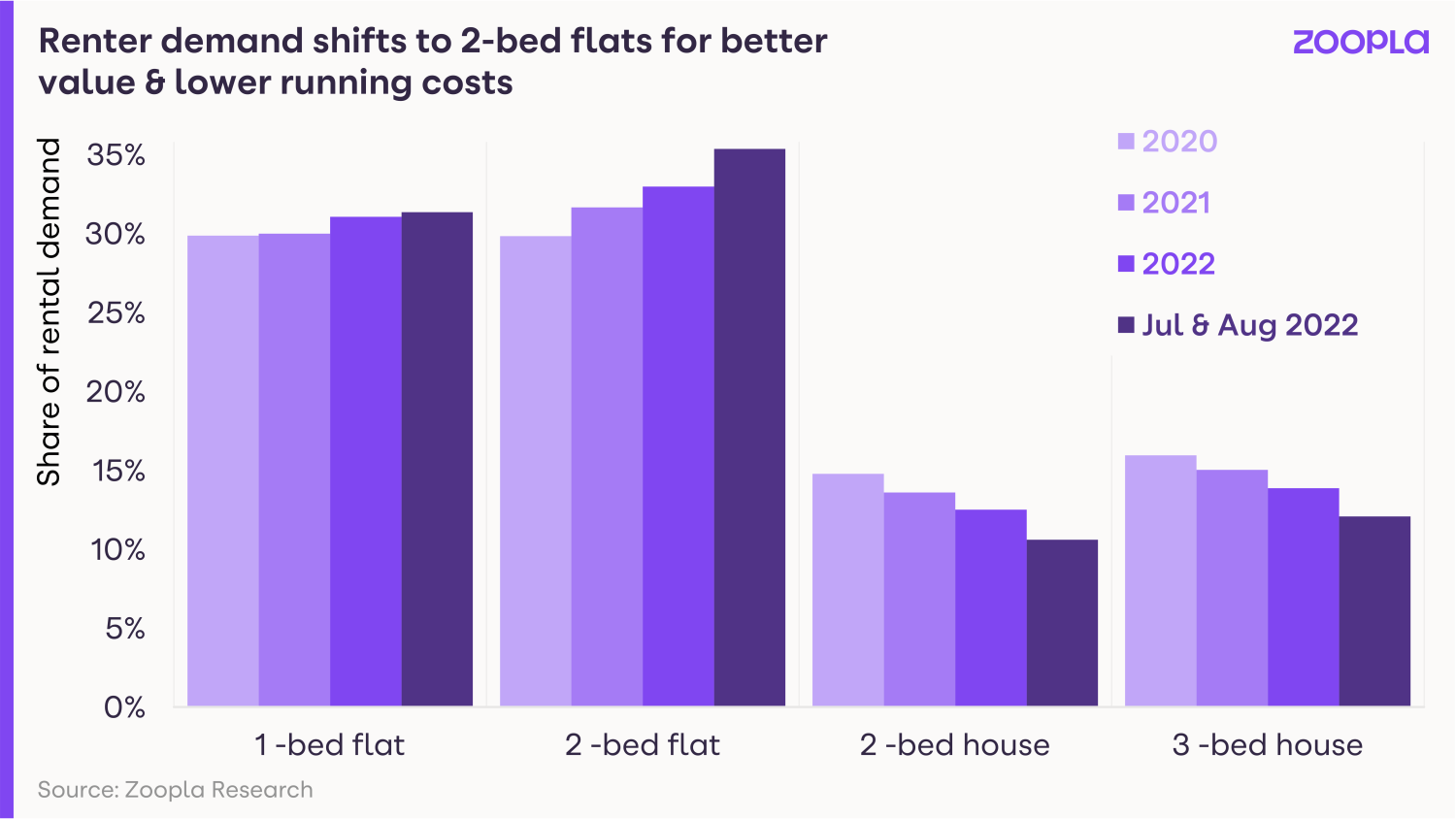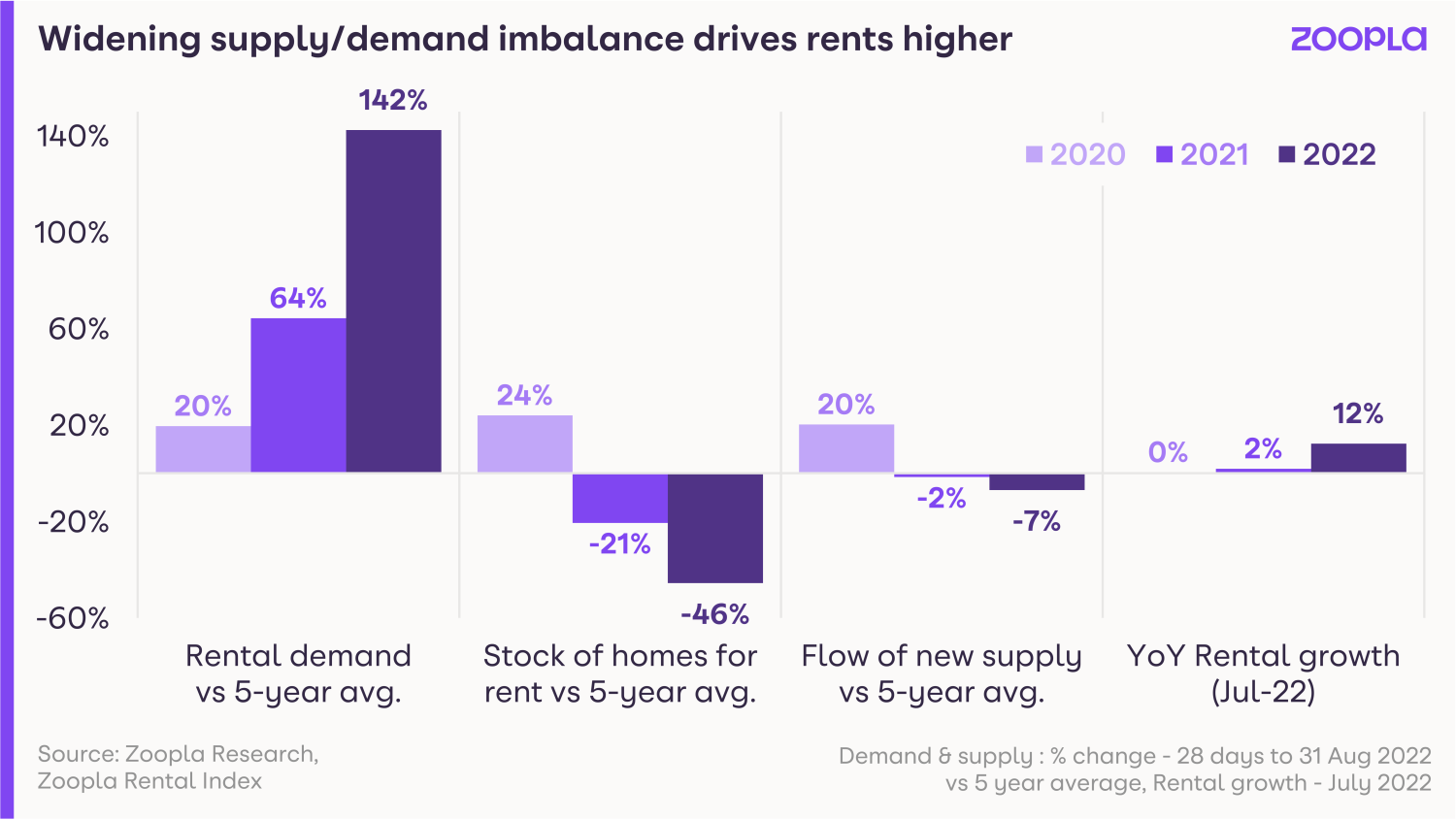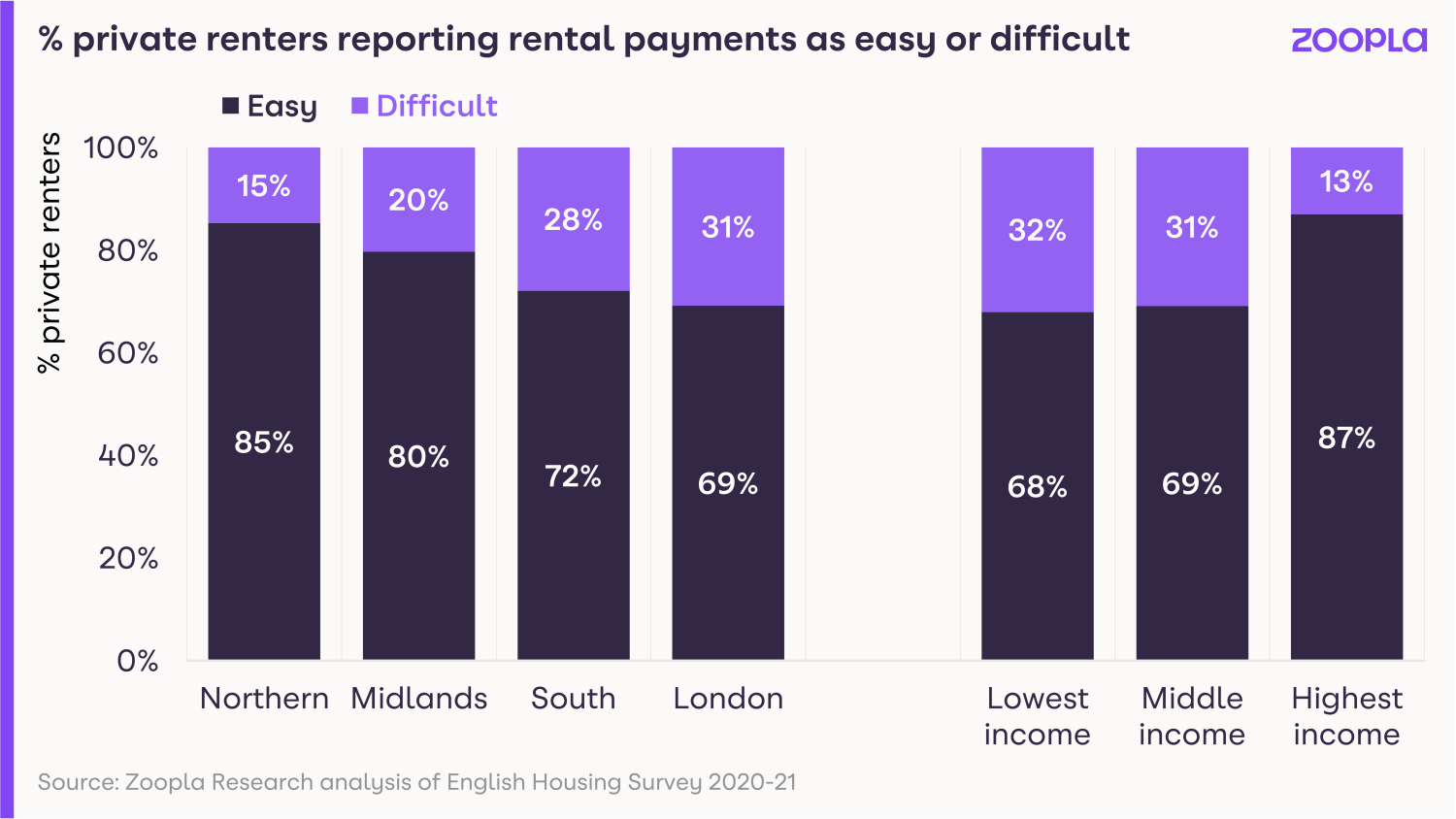Will mortgage rates keep rising and should I remortgage now?
The number of deals available has also fallen but it is still worth remortgaging if you are coming to the end of your deal.
Mortgage rates rose for the 11th month in a row in September and the level of choice fell as the market adjusts to higher interest rates.
The average cost of a two-year fixed rate mortgage reached a nine-and-a-half-year high of 4.24% in September, an increase of 1.9% since December last year.
The typical cost of a five-year fixed rate mortgage also rose to 4.33%, 1.69% more than in December and the highest level since November 2012, according to financial information group Moneyfacts.
Meanwhile, lenders have withdrawn more than 500 mortgage products during the past month, leaving 3,890 different deals for borrowers to choose from, the lowest level since April 2021 and down from more than 5,300 deals at the beginning of December.
The number of different mortgages available fell for all types of borrower, ranging from first-time buyers to those with large equity stakes in their property.
But there was some good news for potential borrowers, with the average amount of time a mortgage is available for before lenders withdraw it increasing from a record low of 17 days in August to 28 days this month.
Why is this happening?
The rise in mortgage rates reflects increases to the Bank of England base rate.
The Bank’s Monetary Policy Committee has hiked the base rate by 1.65% since December last year, as it tries to control inflation.
These increases make it more expensive for lenders to borrow money on the money markets, which is reflected in higher mortgage rates for customers.
Should I still remortgage?
Despite the increase in mortgage rates seen since December last year, it is still definitely worth remortgaging if you are coming to the end of your current deal.
The average standard variable rate – the rate that lenders put you on if you do not remortgage – is currently 5.4%, the highest level since December 2008.
The rate has now increased for nine months in a row, rising by 0.23% in August, the biggest monthly jump since Moneyfacts first started keeping records in December 2007.
And it is expected to continue rising, as standard variable rates typically move up and down in line with changes to the base rate.
Although interest on the average two-year fixed rate mortgage has now reached 4.24%, homeowners with a £200,000 mortgage could still save £136 a month by remortgaging, rather than sitting on their lender’s standard variable rate, even before future interest rate rises are factored in.
Will interest rates rise further?
The short answer is yes. But it is more difficult to predict exactly how much further they will increase by.
The Bank of England is currently increasing interest rates in a bid to bring down inflation.
Economists had previously predicted that inflation would not peak until early 2023, with some predicting it could get as high as 22%.
But following Prime Minister Liz Truss’ energy price freeze announcement, inflation is now expected to peak earlier in November this year and at a lower level of around 11%.
That said, by putting more money back into consumers’ pockets, economists think the energy price freeze will lead to inflation remaining elevated for longer.
As a result, interest rates are also likely to have to remain higher for longer.
Overall, economists are predicting the Bank of England will have to increase the base rate to between 3% and 4% by the middle of next year to get inflation back under control.
That would mean interest rates increasing by between 1.25% and 2.25% from their current level.
Which mortgages are best value?
Deciding what type of mortgage to opt for will depend a lot on your personal circumstances.
At an average of 4.24%, two-year fixed rate mortgages currently look expensive compared with five-year fixed rate ones which average 4.33%.
The premium borrowers have to pay for the security of fixing for five years has been narrowing since December and now stands at just 0.9%.
Meanwhile, the typical interest rate charged on a 10-year fixed rate mortgage is the same as that for a five-year one at 4.33%.
But before opting for a longer-term fixed it is important to remember that what looks like a competitive mortgage rate now, may not look such good value in three or four-years’ time.
The current level of global uncertainty makes it difficult to judge how long interest rates will need to remain high for, but with the UK expected to go into recession, they are not expected to remain high for too long.
It is also important to think about your own personal circumstances, as if you need to exit a five or 10-year fixed rate mortgage early, you are likely to have to pay an early redemption penalty.
These vary according to how long you have left on your mortgage deal. For example, if you have three years left on a five-year fixed rate mortgage, you may have to pay a fee equivalent to 3% of your outstanding mortgage debt.
What about tracker mortgages?
The average rate on a tracker mortgage is currently much lower than that on fixed rate ones, with interest on a two-year deal averaging 3.33%.
But while this may look good value compared with fixed rate mortgages, remember that while the interest you are charged on a fixed rate deal stays the same for the product term, the rate on a tracker one moves up and down in line with changes to the base rate.
As a result, if the base rate increases to 3%, the rate on a two-year tracker mortgage would increase to 4.58%, while if the base rate goes up to 4%, the tracker rate would rise to 5.58%.
How much will my mortgage repayments increase by?
If you are coming to the end of a two-year fixed rate mortgage, the cost of another two-year fixed rate deal is likely to be around 2% higher than when you last remortgaged.
The average interest rate charged on a two-year fixed rate mortgage was 2.24% in September 2020, compared with 4.24% now.
This means someone with a £200,000 mortgage being repaid over 25 years, will see their monthly repayments increase by just over £200 a month.
Of course, if you have a smaller mortgage, the impact will be less, with repayments on a £100,000 loan increasing by around £100 a month in the example above.
What should I do if my mortgage deal still has a few months left?
Deciding what you should do is a bit tricker if your mortgage deal still has a few months left to run.
The first thing you need to do is find out if you would have to pay any fees for exiting you current product early.
If you do and these are high, you may be better off staying where you are.
Next, take a look at what your monthly repayments are now, and what they would be if you remortgaged to one of the products that is available today.
If you are on a very competitive rate, it might work out cheaper for you to stay where you are until the deal ends before remortgaging, even if interest rates have increased by then.
For example, let’s say you currently have seven months left on a two-year fix for a £200,000 mortgage at a rate of 1.5%. Your currently monthly repayments would be £800 a month or £5,600 over seven months.
If you remortgaged to the average two-year fixed rate of 4.24%, your monthly repayments would be £1,095 a month or £7,665 over seven months.
You can ‘book’ a new mortgage deal between three and six months before your current one ends.
As a result, interest rates may only have increased by 0.5% or 0.75% before you are able to secure a new deal.
If interest rates rose by 0.5%, and this was passed on by lenders, your repayments would be £56 a month more than if you remortgaged now.
Under this scenario, you would save £2,065 by delaying remortgaging for seven months, while you would pay a total of £1,344 more in repayments over a two-year mortgage term if interest rates had risen by a further 0.5% by the time you remortgaged, meaning you would be better off delaying.
If interest rates had risen by 0.75% before you remortgaged, it would cost you an additional £86 a month or £2,064 in repayments over two years, meaning you would be in broadly the same position as if you had remortgaged before your term ended, assuming you did not incur any early exist penalties.
Unfortunately, no-one knows exactly what will happen to interest rates in the months ahead, and deciding whether or not to remortgage early will depend on the rate you are paying now.
If you are unsure about what you should do, it may be worth seeking the advice of a mortgage broker.
Key takeaways
- Mortgage rates rose for the 11th month in a row in September and the level of choice fell as the market adjusts to higher interest rates
- The average amount of time a mortgage is available before lenders withdraw it has increased from a record low of 17 days in August to 28 days today
- With the Bank of England base rate expected to rise to 3% or 4%, homeowners coming to the end of a deal should remortgage now
Renters look for smaller homes in cost of living squeeze
Demand for two-bed apartments on the up as renters try to combat rising rent and energy costs.
As the cost of living squeeze looms large, rising rents and energy bills are pushing renters to look for smaller homes in a bid to reduce outgoings.
Our latest data on rental demand shows that renters are shifting their focus from three-bed houses to two-bed flats. And that trend is growing.
With the gas needed to warm a purpose-built flat working out around 40% less than that needed to warm a three-bed family terraced home, or 25% less with a flat conversion, the savings are set to be substantial.
A one-bed home requires less than half the gas that’s needed for a three-bed home.
And D and E rated homes need 25% and 48% more gas to run compared to a C rated home.
The decline in the number of renters looking for two- and three-bed houses in the last year has been significant, as the pendulum of demand swings towards one- and two-bed flats.
And our data suggests the appeal of apartments and energy-efficient homes will only grow as we head into 2023.
The cost of renting is also having an impact on where renters are choosing to live.
Outside of London, the current difference in rents charged for a two-bed flat and a three-bed house is £105 per month.
This translates into £1260 per year in rent, so big savings can be made by moving into smaller apartments.

Yet conversely, despite all of these cost of living headwinds, a chronic undersupply of rental properties available on the market means rents will continue to grow at above average rates into 2023.
Massive supply shortage drives up rents
The average rent has gone up by £115 per month since September last year to £1,051 a month.
The rise is outpacing earnings growth across the country and basically boils down to a major shortage of available homes.
Right now, rental home stock levels are sitting at around half the numbers seen on the market in the past five years, so there’s a lot less choice out there for renters.
Many renters are also deciding to stay put with their current landlords to avoid future rent increases.
And from the landlords’ side, increasing taxes and regulations are causing many to sell up as letting a home becomes less affordable.

Hannah Gretton, Lettings Director at LSL’s Your Move and Reeds Rains brands says: “We are experiencing high levels of demand for rental properties with homes being snapped up within hours of hitting the market.
“With over 270 lettings branches nationwide, it's a picture that is reflected up and down the country with particular demand in urban areas.
“On average, we are seeing double figures of enquiries per property with a one-bedroom property in Manchester last week receiving over 100 requests to view, highlighting just how busy our branches are and the challenges renters face when it comes to finding an appropriate property."
Where are rents rising fastest?
The capital has long been the most expensive place to rent a home and rents here have gone up by 18% on average in the last year.
However, rents did fall by 10% in London during lockdown, so these rent rises are coming up from a low base.
When compared directly with pre-pandemic levels, rents are actually up 7.8% in London. But in the rest of the UK, they’ve risen by 13% on average.
Renters make a return to the cities
Strong employment growth in cities - and the growth in high quality, purpose built build-to-rent homes around the UK - is attracting renters into urban areas.
Energy efficient new-build homes are currently proving to be a big pull, and most new developments tend to be around city centres.
In fact, build-to-rent developments, featuring stylish apartments with luxury on-site facilities, are currently driving the growth of rental housing stock in the UK.
More cost-effective to heat, thanks to brand new energy-efficient boilers, double or triple glazing and low energy lighting, the appeal of new-build homes is growing fast.
However, fierce competition for homes is also leading rents to increase by 10.5% in urban areas, compared with 8.5% in the countryside.
How much higher can rents go?
The private rental market caters for a range of households on low and high incomes, with a quarter of tenants receiving housing benefit.
And while rental affordability varies according to location and income, in the latest English Housing Survey from 2020 to 2021, three-quarters of private renters said they found rental payments very or fairly easy to meet.
Conversely 25% found them fairly or very difficult to pay.

In the North and the Midlands, where rents tend to be cheaper, more tenants found their rent easy to pay. However in the south, more tenants reported that their rent was difficult to pay.
The question of how much higher rents can go will depend on how much headroom renters have to pay more rent.
And while the pace of rent increases is beginning to plateau, our data on rental affordability suggests there is still further headroom for above-average growth in the less expensive areas of the UK.
Apartment rents rising faster at the top end of the market
Asking rents for two-bed flats are rising faster in the top 25% of the market, with growth lagging across the bottom 25% of the market (where demand is more price sensitive).
For three-bed houses, there is less of a difference, but in many regions, the asking rents in the more affordable segments are rising faster.
However, as rented family homes become less attainable, demand for two-bedroom apartments is climbing as renters seek homes that are better value for money.
Rents for non-movers rising at a much slower pace
The average renter moves every four years, so our data reflects rent prices on new lets for around 25% of the market.
However, the Office for National Statistics’ rental index shows rental increases across the board, for movers and non-movers.
It shows current rents across all rented homes are 3.7% higher than they were in July 2021.
However, those moving to a new rented property will find the cost of renting 12.3% higher - as rents for new lets are reflecting the current lack of supply amid high demand across the country.
What’s going to happen to rents in the rest of 2022 and into 2023?
There is no real prospect of a significantly improved rental supply in the near term, as private landlords continue to sell off homes and renters stay put for longer.
The imbalance in supply and demand is here to stay, and rents will continue to rise at above-average levels into 2023 across the more affordable markets.
There is headroom for some renters to pay more - especially outside London and the South East - where rents are already high.
We expect the headline rental growth to slow over the rest of 2022 and into 2023 - but it won’t happen quickly.
Executive Director says: “Rents have surged ahead over the last year but there are signs that the pace of growth is peaking and set to slow into 2023.
“Renters are responding and looking for smaller, better value for money homes to rent with an eye on energy costs as much as rental levels.
“What the rental market needs to combat these challenges is more new homes for rent.
“Greater regulation has discouraged some landlords from investing and more are exiting, meaning the rental market has stopped growing since 2016.
“There is a risk that more regulation to improve standards or potential new measures to dampen rental growth, as proposed in Scotland, may compound the supply problem which is pushing rents up in the first place.
Key takeaways
- Renters are choosing two-bed apartments over three-bed family homes to reduce outgoings as the cost of living rises
- Rents on new lets have gone up £115 per calendar month compared with this time last year, rising faster than wages
- In a market where demand is massively outstripping supply, rents are likely to keep going up into 2023


